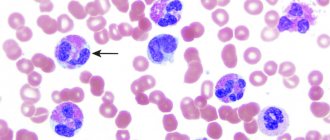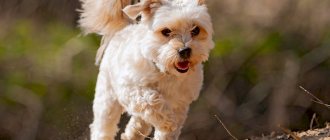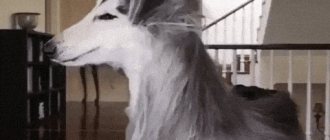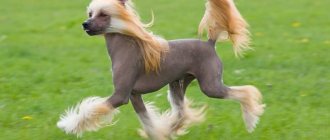In American kennel clubs, the pug breed is often called the “Grumble”. This nickname comes from the fact that pugs snore, grunt, and make funny snorts when they sleep and when they are awake. However, you don’t always need to be touched by this funny breed feature of dogs. In some cases, a pet's snoring indicates the presence of serious pathologies that require veterinary intervention.
What are the causes of snoring in dogs of this breed? What can you do to make your pug snore less? When should a pet's snoring alert its owner? Look for answers to all these questions in our material.
What is snoring
Anyone who has heard how funny pugs snore is wondering what these funny sounds mean? What is snoring in dogs?
Snoring is a phenomenon characterized by vibration of the soft tissues of the larynx and pharynx. During vibration, specific low-frequency rattling sounds appear. This physiological process occurs due to the fact that air flows come into contact with the relaxed muscles of the pharynx and larynx.
Many dog breeds snore. Some people do this from time to time only during sleep. Pugs belong to the group that can make such sounds even during periods of wakefulness.
How to treat a stuffy nose and hoarse breathing at home
When the first cold symptoms appear, it is important:
Cover your sleeping area with a blanket to keep you warm.
If your condition worsens, be sure to consult your doctor. Cold symptoms disappear after 2-3 days, so long-term persistence of alarming signs requires diagnosis.
Cold symptoms should not last longer than 3 days.
Medication treatment for a puppy
At the first symptoms of a cold, contact your veterinarian.
You can treat a runny nose (snot, stuffy and runny nose), sneezing, fever and other cold symptoms with:
Please note that self-administration of medications is not recommended. Without exact certainty about the cause of the disease, the pet’s condition can worsen.
Forget about paracetamol treatment. The classic antipyretic is toxic to animals.
Treatment with folk remedies is also unsafe, because herbs can provoke an allergic reaction.
Avoid the popular vodka treatment. Blood thinners are used only in life-threatening situations. Remember that you will not be able to get rid of the resulting toxins on your own.
Why do pugs snore?
The causes of snoring in dogs are varied. But, if your pug snores, then with almost 100% probability he does this because of his genetic characteristics. Yes, it's all genetics! Pugs belong to the group of brachycephalic dog breeds. Along with them there are Shih Tzus, Boxers, Pekingese, Bulldogs, and Shar-Peis.
Brachycephalic breeds are the result of deliberate selection. Selection that resulted in the development of dog breeds with shortened (flat) muzzles. This work of breeders led not only to changes in the dogs’ appearance, but also changed their physiology. To a greater extent this affected the structure of the breathing apparatus. Brachycephalics have narrowed nostrils, an enlarged soft palate, and a pathological structure of the trachea.
These genetic changes in the structure of the respiratory apparatus are the answer to the question: “Why do pugs often snore?” They snore because they have breathing problems. Each dog experiences breathing problems to varying degrees. For some they are almost invisible, for others they may require veterinary care. But all pug dog owners should be aware that these health problems can cause their pets to “faint” in the heat or in stressful situations.
Important: be attentive to your pugs in hot weather, do not allow them to overheat, walk in the shade and wear a Panama hat! Never leave dogs in a closed vehicle. This could cost your pet's life.
Preventive measures
It is necessary to urgently show the dog to the veterinarian.
To prevent shortness of breath, it is recommended to provide the dog with good care. Food should include all vitamins and minerals, especially iron and calcium. You need to check your heart function often and protect your pet from infectious diseases.
If the breed is prone to shortness of breath, you should regularly visit the veterinarian and monitor the condition of the respiratory tract. If a dog has serious illnesses or injuries to the central nervous system (for example, epilepsy or concussion), you must carefully monitor its well-being and follow all the veterinarian’s prescriptions.
When walking, do not tighten the collar or harness on the dog's neck too tightly. A tight and tight collar will constantly suffocate your pet. This will inevitably lead to breathing problems.
Important! The dog needs a soft and elastic collar that does not put pressure on the neck.
You need to take care of the puppy’s health from the first days of its life, then the adult dog will always feel good. You need to feed your furry pet well and choose a comfortable collar for it.
What Can Cause Your Pug's Snoring to Increase?
Anyone who has ever heard a pug snore at least once knows that this does not happen with the same frequency and intensity. On some days, dogs are practically inaudible; they do not disturb their owners’ sleep. Other times, the roar of a grunting dog keeps the whole family awake. Let's talk about why this happens?
Reasons why pugs snore more:
- Allergic reaction. Yes, pugs can't help but snore. But they, like all dog breeds, may be allergic to smoke, pollen, food, dust, and human dander. Dogs react especially strongly to tobacco smoke. All smoker owners should remember this. Allergies make your dog snoring worse.
- Obesity and overweight. Excess weight causes the nasal passages to block the airways. This is the most common cause of snoring in all dog breeds. Pugs are no exception.
- Foreign object in the throat or nasal passages. Pugs are curious, they often stick their nose into places they shouldn't. Therefore, small pebbles, blades of grass, twigs or toys may get stuck in their nose or throat. A foreign object interferes with the dog's breathing, causing it to snore. The problem resolves itself after removing the foreign body. If your pug grabs everything in sight on the street, then we recommend wearing a pug muzzle when walking.
- Colds. Just like people, pugs get stuffy noses during respiratory diseases, infections and inflammations in the nasal cavity. When you have a cold, breathing becomes difficult - this increases snoring.
- Age-related changes. Older dogs snore more and more heavily. Pug puppies practically do not snore. It is difficult to do anything about snoring as you age.
- Medicines. Snoring may occur or become worse in dogs while taking certain medications. It is difficult to explain why pugs snore and grunt more during drug therapy, but this goes away after it is completed.
- Sleeping position. Another common reason for increased snoring in dogs. Pugs that sleep on their back snore more often.
- Helminthiasis. Worms that penetrate the heart, brain and blood can cause snoring.
Important: Be sure to take your dog to the vet if his snoring increases. The doctor will help determine and eliminate the cause of this phenomenon.
Diagnostic methods
Shortness of breath and heavy breathing is not a disease, but a sign of illness or injury. It is important to know which factor caused shortness of breath. Therefore, first of all, the veterinarian conducts diagnostics to understand why exactly the dog is suffocating. To do this, they do an X-ray, ECG, ultrasound, MRI, general blood test, check for parasites and other procedures.
If a foreign body enters the respiratory tract, the doctor must remove it and then, if necessary, perform artificial ventilation of the lungs.
In case of head or chest injury, surgery is performed, followed by a comprehensive course of treatment. If fluid has accumulated in the chest, the veterinarian will remove it. This operation is called thoracentesis.
Colds and inflammatory diseases are treated at home with prescribed medications. For anemia, a therapeutic diet is also prescribed. The drugs used are diuretics, analgesics, immunostimulants, and anti-inflammatory drugs.
What to do if your pug's snoring becomes dangerous
Now let's talk about in what cases the owner of a pug should sound the alarm and call a veterinarian for help.
Brachycephalic syndrome
The most terrible complication of difficulty breathing, which manifests itself in pugs as snoring, is brachycephalic syndrome. The condition is serious and can lead to frequent fainting, disruption of the cardiovascular system and death.
How does brachycephalic syndrome manifest?
- rapid difficulty breathing, severe snoring;
- hyperthermia;
- shortness of breath, difficulty breathing;
- blue discoloration of mucous membranes;
- nausea;
- vomiting with white foam;
- right-sided heart failure;
- fainting.
If your veterinarian has diagnosed your pet with a brachycephalic symptom, do not despair! This condition is treated with plastic surgery.
Planned surgery
Planned surgical intervention is performed while the pet is young, he is under three years old. In this case, the operation consists of widening the lumen of the nostrils and removing excess tissue of the soft palate.
Indications for surgical intervention:
- “reverse sneezing syndrome” - rapid, convulsive breaths accompanied by grunting sounds;
- severe narrowing of the nostril passages;
- difficulty breathing accompanied by snoring.
A competent and timely operation is the key to preventing the development of a dangerous pathology.
Important: dogs older than 3 years old develop other abnormalities in the structure of the head, so it is more difficult to operate on them. The standard operation includes excision of the folds of the larynx with displacement of the arytenoid cartilage with suturing.
Signs characteristic of shortness of breath
To understand why your dog is breathing hoarsely, you need to remember the main signs of shortness of breath. At the first symptoms, you need to help your pet and go to the veterinarian.
Types of shortness of breath:
- A short inhalation and a long, heavy exhalation (expiration) - this happens with asthma and bronchitis.
- A sharp, heavy, short breath (inspiration) - pulmonary edema, injury to the chest and respiratory organs, foreign body.
- Both inhalation and exhalation are difficult (mixed type) - pneumonia, heart failure, inflammatory process.
All types of shortness of breath have extensive symptoms:
- the dog cannot breathe with its mouth closed;
- the dog wheezes as if suffocating;
- cough;
- pale or bluish tint of mucous membranes;
- the dog makes a great effort to breathe;
- whistling, wheezing;
- the dog stretches its body and spreads its front paws wide;
- At first there is severe anxiety, and then the dog becomes indifferent to what is happening.
The animal must be helped immediately, otherwise irreversible pathology and death may develop.
When choking, the dog may open its mouth and stick out its tongue.
Emergency help
Depending on the severity of the dog’s condition, emergency treatment is divided into surgical and medical.
Surgical assistance
An unscheduled operation is performed in emergency cases when it is necessary to save the dog. Most often, this operation is performed when a pug is diagnosed with suffocation due to brachycephalic syndrome. In this case, the veterinarian performs a tracheostomy - an incision in the trachea in the throat area so that the pug can breathe freely.
Drug therapy
If the dog’s condition is not critical, the doctor is limited to the following measures:
- decrease in body temperature;
- hormonal steroid therapy;
- sedatives;
- oxygen inhalation.
All these measures help stop the attack, but do not save from its recurrence in the future. After emergency assistance is provided, the owner is advised to think about operating on the pet. This will help the pet live to a ripe old age, protect it from suffocation in the future, and maintain the health of the heart muscle.
When to contact a veterinarian
If your pet is choking, you should contact your veterinarian as soon as possible for any symptoms.
It is necessary to urgently treat your dog if it develops life-threatening symptoms:
- the dog is trembling (runny nose, wheezing, heavy breathing);
- mucous membranes have turned blue or pale;
- the tongue falls out of the mouth;
- convulsions;
- heart attack.
You need to calm your pet down and call a doctor immediately. If the dog is not helped in time, it may suffocate.
Important! Dyspnea (difficulty breathing) should not be confused with tachypnea (fast but not heavy breathing). Tachypnea often develops after running and physical activity.
The pet should be placed in a cool place and given medicine
Diagnosis and treatment
To establish the exact cause of a dog’s cough and select effective therapy, the veterinarian will not only examine the pet and interview the owner, but will also prescribe additional examinations:
After reviewing the results and making a final diagnosis, the specialist will prescribe appropriate treatment.
- Allergy symptoms are relieved with antihistamines. Dogs are also prescribed immunomodulators.
- Emollients and expectorants will help relieve cardiac cough. Yorkies, pugs, chihuahuas and spitz dogs with this diagnosis are prescribed a gentle exercise regimen and a special diet.
- Parasitic cough can be relieved with anthelmintic medications. They are selected taking into account the weight of the dog and the type of pathogen.
- Cough caused by the presence of a cancerous tumor is relieved by drugs that expand the lumen of the bronchi. To stabilize a dog with cancer, expectorants, echinacea, steroids, bronchodilators and vitamins are prescribed.
Redness of the ears
Another weak point of the breed. The peculiar shape of the skull is the cause of their frequent inflammation. This disease is called otitis and is characterized by redness of the inside of the ears.
Often the disease can be confused with an allergy. Since the symptoms are the same.
But with otitis media, symptoms such as the release of large amounts of wax, squelching of fluid in the ears, and discharge with an unpleasant odor also appear. Peeling and itching are more likely to indicate an allergic reaction. In any case, only a veterinarian can make an accurate diagnosis. He will prescribe the necessary treatment.
How should a healthy dog breathe?
Let's figure out how a healthy dog should breathe. The breathing rate depends on the size of the dog; the larger the size, the fewer breaths it takes per minute. The respiratory rate is measured by recording the movements (raising) of the ribs.
For large dogs, 12-18 lifts per minute is considered normal. Small dogs breathe more quickly, approximately 18–24 breaths per minute. Both the frequency and depth of inspiration are recorded. If, when a dog inhales, the peritoneum, and not the chest, enlarges, this is a symptom of a dysfunction of the respiratory system. In addition, the respiratory rate is measured in conjunction with the pulse.










